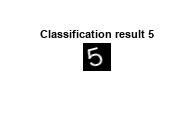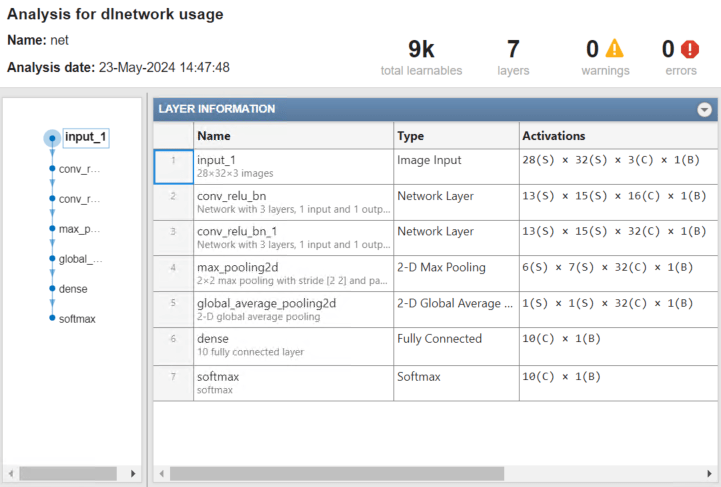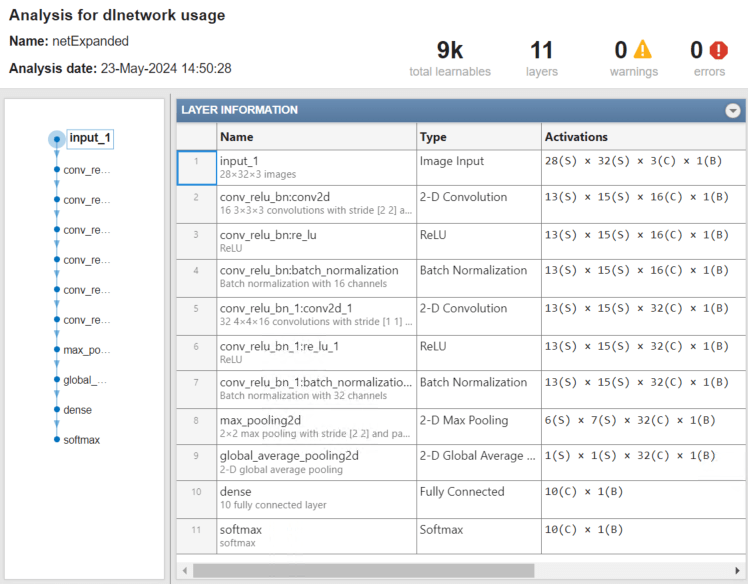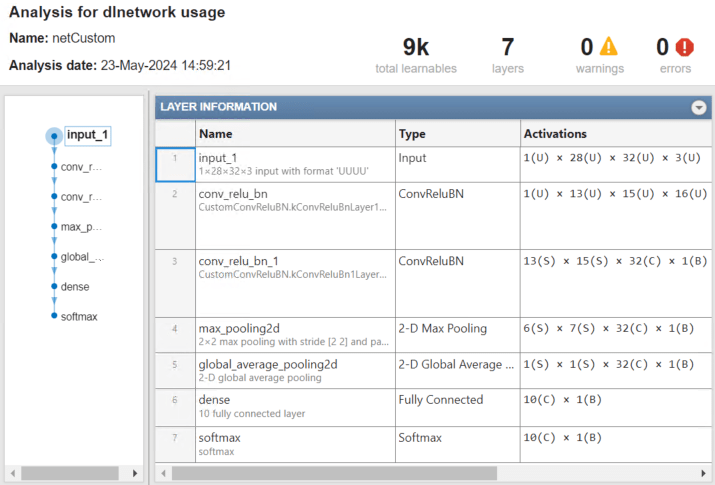importNetworkFromTensorFlow
Syntax
Description
net = importNetworkFromTensorFlow(modelFolder)modelFolder, which contains the
network in the SavedModel format. The network comprises the layers defined in the
saved_model file with the .pb extension and the
learned weights in the variables subfolder. The function returns the
network net as an initialized dlnetwork object.
importNetworkFromTensorFlow requires the Deep Learning Toolbox™ Converter for TensorFlow Models support package. If this support package is not installed, then
importNetworkFromTensorFlow provides a download link.
Note
The importNetworkFromTensorFlow function can generate a custom layer when
importing a TensorFlow layer. For more information, see Algorithms. The function saves
the generated custom layers in the +modelFolder
namespace.
net = importNetworkFromTensorFlow(modelFolder,Name=Value)
Examples
Input Arguments
Name-Value Arguments
Output Arguments
Limitations
importNetworkFromTensorFlowhas been tested for TensorFlow versions 2.0 to 2.15.importNetworkFromTensorFlowsupports models created with the Keras 2 API. New features introduced in the Keras 3 API are unsupported.
More About
Tips
To use a pretrained network for prediction or transfer learning on new images, you must preprocess your images in the same way as the images that you use to train the imported model. The most common preprocessing steps are resizing images, subtracting image average values, and converting the images from BGR format to RGB format.
For more information about preprocessing images for training and prediction, see Preprocess Images for Deep Learning.
The members of the
+namespace (custom layers and TensorFlow operators) are not accessible if the namespace parent folder is not on the MATLAB path. For more information, see Namespaces and the MATLAB Path.NamespaceMATLAB uses one-based indexing, whereas Python® uses zero-based indexing. In other words, the first element in an array has an index of 1 and 0 in MATLAB and Python, respectively. For more information about MATLAB indexing, see Array Indexing. In MATLAB, to use an array of indices (
ind) created in Python, convert the array toind+1.For more tips, see Tips on Importing Models from TensorFlow, PyTorch, and ONNX.
Algorithms
The importNetworkFromTensorFlow function imports a TensorFlow layer into MATLAB by trying these steps in order:
The function tries to import the TensorFlow layer as a built-in MATLAB layer. For more information, see TensorFlow-Keras Layers Supported for Conversion into Built-In MATLAB Layers.
The function tries to import the TensorFlow layer as a built-in MATLAB function. For more information, see Supported TensorFlow Operators.
The function tries to import the TensorFlow layer as a custom layer.
importNetworkFromTensorFlowsaves the generated custom layers and the associated functions in the+namespace. For an example, see Import TensorFlow Network with Automatically Generated Custom Layers.NamespaceThe function imports the TensorFlow layer as a custom layer with a placeholder function.
importNetworkFromTensorFlowsaves the placeholder function in the+opsinner namespace of the+namespace. You must complete the placeholder function before you can use the network.Namespace
In some cases, the software will indicates that you need to initialize the imported network. For an example, see Import and Initialize TensorFlow Network.
Alternative Functionality
App
You can also import networks from external platforms by using the Deep Network Designer app. The app uses the
importNetworkFromTensorFlow function to import the network, and displays a progress
dialog box. During the import process, the app adds an input layer to the network, if
possible, and displays an import report with details about any issues that require
attention. After importing a network, you can interactively edit, visualize, and analyze the
network. When you are finished editing the network, you can export it to Simulink® or generate MATLAB code for building networks.
Block
You can also work with TensorFlow networks using the TensorFlow Model Predict block. The TensorFlow Model Predict block additionally allows you to load TensorFlow functions to preprocess and postprocess data, and to configure input and output ports interactively.
References
[1] TensorFlow. “TensorFlow.” Accessed July 3, 2023. https://www.tensorflow.org/.
[2] TensorFlow. “Using the SavedModel Format | TensorFlow Core.” Accessed July 3, 2023. https://www.tensorflow.org/guide/saved_model.
Version History
Introduced in R2023bSee Also
importNetworkFromONNX | importNetworkFromPyTorch | exportONNXNetwork | exportNetworkToTensorFlow | trainnet | dlnetwork | dlarray
Topics
- Interoperability Between Deep Learning Toolbox, TensorFlow, PyTorch, and ONNX
- Tips on Importing Models from TensorFlow, PyTorch, and ONNX
- Inference Comparison Between TensorFlow and Imported Networks for Image Classification
- Pretrained Deep Neural Networks
- Deploy Imported TensorFlow Model with MATLAB Compiler




